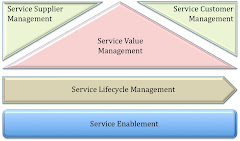Thursday 25 November 2010
BSM at ACIS 2010
Sunday 19 September 2010
Representation of Strategy Using i*-like Notation
Assessing and achieving alignment between an organization's strategies and its IT/business functions has long been recognized as a critically important question. This paper reports on a project that seeks to overturn established management orthodoxy by establising that strategies can be adequately modeled using conceptual modeling nota- tions and that methodological and tool support can be provided for the task of assessing and achieving alignment between the strategies of an organization and its service offerings. A key element of this enterprise has been the design of SML - the Strategy Modeling Language. This paper presents an interim report from this project that describes how a nota- tion inspired by i* has been used to obtain the diagrammatic modeling component of SML, and how i*-like notions have been used to represent strategy decomposition (required to be able to refine strategies to a level where there is an onotlogical match between the languages used to de- scribe strategies and services). We also comment on how i*-like notions would play a greater role in this project, as a complete model of the en- terprise context is brought to bear on the alignment exercise. We provide a brief illustration, and a description of the toolkit implemented on the Eclipse platform.
See here for more information.
Monday 13 September 2010
Identification and specification of relationships as the foundation for service bundling
See here for more information.
Thursday 9 September 2010
Service identification through value chain analysis and prioritization
In a resource constrained business world, strategic choices must be made on process improvement and service delivery. There are calls for more agile forms of enterprises and much effort is being directed at moving organizations from a complex landscape of disparate application systems to that of an integrated and flexible enterprise accessing complex systems landscapes through service oriented architecture (SOA). This paper describes the deconstruction of an enterprise into business services using value chain analysis as each element in the value chain can be rendered as a business service in the SOA. These business services are explicitly linked to the attainment of specific organizational strategies and their contribution to the attainment of strategy is assessed and recorded. This contribution is then used to provide a rank order of business service to strategy. This information facilitates executive decision making on which business service to develop into the SOA. The paper describes an application of this Critical Service Identification Methodology (CSIM) to a case study.
See here for more information.
Sunday 29 August 2010
Conceptualizing a bottom-up approach to service bundling
See here for more information.
Saturday 31 July 2010
Sourcing business and software services
In this paper, we address this need by discussing the relations between a comprehensive service lifecycle approach for service management & engineering and the sourcing & purchasing of services. In particular we pay attention to the similarities and differences between sourcing business and software services, the alignment between service management & engineering and sourcing & purchasing, the role of sourcing in the transformation of an organization towards a service-oriented paradigm, the role of architectural approaches to sourcing in this transformation, and the sourcing of specific services at different levels of granularity.
See here for more information.
Sunday 9 May 2010
Definition of a Description Language for Business Service Decomposition
See here for more information.



